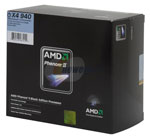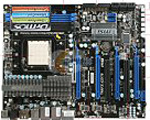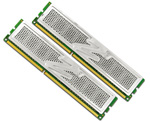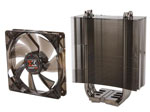AMD Performance Midrange
With Phenom II, an apology is no longer needed when putting together an AMD performance midrange system. While the Phenom was an honest competitor at the price points where AMD chose to compete, the poor overclocking of the AMD Phenom compared to Intel Core 2 Duo and Quad processors was always a nagging reality. Phenom II changes all that, and AMD in 45nm clothes is once again a screaming overclocker. We have reached 3.9-4.0GHz in internal Phenom II testing, which places the Phenom II squarely into Intel Core 2 overclocking territory. The days when AMD meant lots of overclocking headroom have finally returned - at least through the midrange CPUs.
| AMD Performance Midrange PC | ||
| Hardware | Component | Price |
| Processor | Phenom II x4 955 Black Edition (3.2GHzx4 125W 4x512KB L2, 6MB L3) | $200 |
| Cooling | Xigmatek HDT-S1283 120mm Rifle CPU Cooler - Retail (after $10 Rebate) | $27 |
| Motherboard | MSI 790FX-GD70 AM3 DDR3-2000+ | $170 |
| Video | MSI Radeon HD 4890 1GB OC Edition (After $30 Rebate) | $170 |
| Memory | OCZ Platinum AMD Edition 4GB (2 x 2GB) DDR3 1600 (PC3 14400) Low Voltage Model OCZ3P1600LVAMGK 7-7-7-24 | $87 |
| Hard Drive | Western Digital Caviar Black 1TB WD1001FALS | $95 |
| Optical Drive | LG BD/HD DVD 8X BD read/16x DVD read/write CH08LS10 - Retail | $130 |
| Audio | On-Board | $ - |
| Case | Cooler Master Storm Scout SGC-2000-KKN1-GP Mid-Tower | $100 |
| Power Supply | Corsair CMPSU-750TX 750w 80 PLUS Certified SLI/Crossfire Ready Core i7 Power (after $20 Rebate) | $100 |
| Base System Total | $1079 | |
| Display | ASUS VW266H Black 25.5" 2ms(GTG) HDMI Widescreen LCD Monitor (1920x1200) (after $30 Rebate) | $300 |
| Speakers | Logitech G51 155 watts RMS 5.1 Surround Sound Speakers - Retail | $120 |
| Input | Microsoft CA9-00001 Black PS/2 Standard Keyboard and Optical USB/PS2 Mouse - OEM | $16 |
| Operating System | Microsoft Vista Home Premium OEM | $99 |
| Complete System Bottom Line | $1614 | |
| SSD (Optional) | OCZ Vertex OCZSSD2-1VTX120G 2.5" 120GB SATA II MLC Internal Solid State Disk | $339 |
 |
The Phenom II 955 Black Edition at 3.2GHz x4 is the fastest of the currently shipping AMD Phenom II processors. Recently the Phenom II 955BE has been frequently on sale, as it is right now for just $199.95. That is a great price on the flagship Phenom II and it brings tremendous value to the AMD performance midrange system. The Phenom II is very similar in L2/L3 cache configuration to the Intel Core i7, but i7 is clearly the better performer and the fact it sells for more reflects that reality.
 |
We've paired the Phenom II 940 with the MSI 790FX-GD70 motherboard based on the 790FX chipset. While the 790FX is an older chipset than the 790X and 790GX, it still provides features like true dual x16 PCIe slots that are not available in the newer chipsets. Internal testing also shows performance is slightly better with the FX chipset than the newer chipsets, making this board an ideal match to the top 955BE Phenom II.
 |
Since the MSI supports dual-channel DDR3, the motherboard was populated with a 4GB kit of OCZ Platinum AMD Edition. This low-voltage memory is rated at 7-7-7 timings and DDR3-1600 at just 1.65V. It performs well at faster timings and lower voltages at slower speeds. Whether you use it as a stock DDR3 memory or overclock it to its limits, this OCZ memory should provide the headroom you need to bring out the best in this system.
 |
The Phenom II is not the hot CPU you find in the Core i7, but it still benefits from third party cooling - particularly if you plan to overclock. We paired the Phenom II 955BE with the Xigmatek S1283 120mm Rifle that performed well in the lab. At $27 after a $10 rebate, the Xigmatek is also an excellent cooling value. It is the same cooler recommended for the AMD value system.
Other components in the AMD performance midrange system are the same used in the Intel performance midrange. You can find descriptions and thumbnail images of those common components on the next page.
Finally, you should notice that the AMD performance system, using the current top Phenom II and DDR3 memory, is around $150 cheaper than the Intel Core i7 performance midrange system. The reason for this is very simple, namely the Core i7 is a better performing system that is priced accordingly. It just means AMD and Intel are competitively priced these days and the comparative costs of an Intel or AMD CPU is now a good indicator of the relative performance. There are always exceptions to a broad statement like this, but generally pricing and performance are fairly gauged in today's market.










71 Comments
View All Comments
ChrisOjeda - Monday, July 27, 2009 - link
Will onboard video (like ASUS M4A78T-E) be a solid solution for somebody that does no gaming, but would like to make a home theatre box for watching movies, playing music, and viewing pictures using a Windows solution. I have no intention of gaming on the machine and don't want to spend more than necessary for a video card. Assume all other components the same.JarredWalton - Monday, July 27, 2009 - link
Yes. If you're a stickler for audio, make sure it's an IGP that can handle multi-channel LPCM audio output. NVIDIA has had this for a while, Intel added it a year or so back, and http://www.anandtech.com/weblog/showpost.aspx?i=62...">AMD just added it with the R785 (HD 4200).garydale - Monday, July 27, 2009 - link
The AMD 790GX chip does pretty reasonable graphics for the non-gamer so I went with the Gigabyte GA790GP-UD4H (or some similar number) board. The six onboard SATA2 ports meant that my software RAID 5 array (4 x 500G) still allowed me to plug in a SATA DVD rewriter.With a Phenom II 940 processor, the total build (less monitor - still using an old Dell 21" trinitron) was pretty small. I found a 470watt PC Power & Cooling Silencer on sale last year and stuffed it in a case I'd picked up years ago.
The processor runs quite cool thanks to the new cooler AMD puts on them - about the same temp I was getting with with an earlier Phenom X4 and a Gladiator Max cooler. It's the hard drives that are running hot, so I'll need to add another fan at the back to pump more hot air out.
Just waiting for the Blu-ray burner costs to come down. They haven't really moved in the last year, which is disappointing. Does anyone have any idea on why the prices are staying high? I notice the media prices have been dropping, so when can we expect a $100 Blu-ray burner?
goinginstyle - Monday, July 27, 2009 - link
I was surprised that I did not see a AMD 770 or cheap Intel P45 based system with the 4890 as the video card choice for the midrange system. The money you save on the board allows you to upgrade the video card choice and performance looks to be the same. Maybe overclocking is not as good but does it really matter that much.You end up with a single video card on the board but it also allows you to save money on the power supply choice, which might get you a better audio selection or two hard drives. I think having alternatives listed in these guides would be good, otherwise most of the choices were solid.
brybir - Monday, July 27, 2009 - link
I was looking for the 780G as well. I think they were looking for "gamer" boards with the option to Crossfire or SLI or whatnot over strictly budget options since this is a "middle of the road" system guide for both casual gamer types as well as those in the upper end of the price range who want very good system speed.If I were building a mid range system (I am going to build one come early 2010 when Intel's i5 line is more flushed out and the new gen of graphics cards are released in oct/now) I would probably pick up a 780G board and use the money to go from the 4870 to the 4890 or even just use the money for a bump in LCD quality.
Black Jacque - Monday, July 27, 2009 - link
This article makes some good points in graphics and CPU selection. However, it shows the Editors have a poor understanding of PC power consumption.By reasonable accounts, all the PSUs in the recommended systems have twice the rated wattage that the parts lists will draw at full core-burning maximum. For the mid-range, a 400W-450W PSU is more than enough.
The recent, excellent Xbit Labs article "PC Power Consumption: How Many Watts Do We Need?" clearly illustrates that 750W PSUs are a waste of money in the mid-range when not going with SLI or Crossfire. This article shows the trend in PC parts is downward in power consumption.
When building a mid-range machine, you need to keep your eye on your budget. You are trading dollars for performance in every choice. A 450W PSU is less expensive than a 750W PSU. That difference is one budget bump UP toward either a: faster CPU, an upgraded GPU, or more RAM.
The high-wattage PSUs in the parts lists show a poor understanding of PC power consumption. Selecting lower wattage, PSUs that perform as needed in high performance situations (and more efficiently at idle) allows for higher performance parts to be used in the price/performance mid-range categories, or generally lower the cost-of-entry to a category. I expected a more canny and not “Big is Best” recommendation of PSUs in this article.
The0ne - Monday, July 27, 2009 - link
While there's already arguments going back and forth on this it's usually a good idea to buy a beefier but not necessarily more expensive PS. The reason is because many users don't have the capability to determine precisely how much power their system is consuming. Hell, I'm an Engineer and I don't have the tools at home to even do it. So I can't expect the same for your average Joe to be capable of. Secondly, not all low range, mid-range or high end configurations are the same. Some have more components and some have the basics. Having more requires a bit more power.In addition, not all power supplies are created equal. Even same power supplies are not exactly the same. And while specs are great to look at chances are if you don't know what you have in the first place it's best if you look for a performance/price deal that is more than what you "think" you need.
Due to reviews I keep seeing people make comments like "consumers only need 400-450 watt for their mid-range computer!" While this may be true for most cases it is not entirely 100% foolproof. For example, my 600watt PS in my main refuses to run my new 4870 1Gig video card where it's already powering my current 9800GX2. Why, I've no idea. I just know that I had spent hours trying to determine it with little success except the PS is not what the specs are telling me.
So I pop in the OCZ 700, after doing some research and knowing I would have some good buffer afterward, and my system is running just fine. I'm not maxing it so I really don't have to pay attention to the tight specifications. What matters was that I bought it for $50 when it was on sale and there wasn't a similar PS that came close in price. That's what importantly :)
SiliconDoc - Wednesday, August 5, 2009 - link
You don't need home tools to determine what PS requirements are, there are tools all over the internet - how about one form the experts:http://www.thermaltake.outervision.com/">http://www.thermaltake.outervision.com/
---
Now they make PS's and you would think they would promote a higher number, but run through it once and you'll likely find a much lower result than you expected.
The0ne - Monday, July 27, 2009 - link
Speaking of PS, here's the one I got...and it's on sale again for $49 after rebate :ohttp://www.zipzoomfly.com/jsp/ProductDetail.jsp?Pr...">http://www.zipzoomfly.com/jsp/ProductDetail.jsp?Pr...
Nfarce - Monday, July 27, 2009 - link
"For the mid-range, a 400W-450W PSU is more than enough. The recent, excellent Xbit Labs article "PC Power Consumption: How Many Watts Do We Need?" clearly illustrates that 750W PSUs are a waste of money in the mid-range when not going with SLI or Crossfire."Uhm, yes and no. As someone who recently build an E8400 mid range gaming system who also has the Corsair 750W, there are things you need to consider other than pure wattage. For instance there are hardly any quality power supplies in the 450-550W range that offer 2 6-pin PCIe connectors (a requirement to run HD 4870/90 and GTX 260/275 cards). Finally, the ones that do aren't that much less expensive. If you are going to spend $75 on a minimum requirement power supply, it makes good long term sense to throw in another $25 and get a more powerful PS for your future upgrade needs. Power supplies, unlike other PC components, don't really drop in price over time.